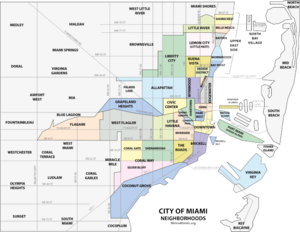Little Havana
|
Little Havana La Pequeña Habana |
|
|---|---|
| Neighborhood of Miami | |

Little Havana's famous Domino Park on Calle Ocho
|
|
 Little Havana neighborhood within the city of Miami |
|
| Coordinates: 25°46′21.28″N 80°12′52.52″W / 25.7725778°N 80.2145889°W | |
| Country | United States |
| State | Florida |
| County | Miami-Dade County |
| City | Miami |
| Government | |
| • City of Miami Commissioner | Frank Carollo |
| • Miami-Dade Commissioners | Bruno Barreiro |
| • House of Representatives | David Richardson (D) |
| • State Senate | José Javier Rodríguez (D) |
| • U.S. House | Ileana Ros-Lehtinen (R) |
| Population (2010) | |
| • Total | 76,163 |
| • Density | 21,815/sq mi (8,423/km2) |
| Time zone | EST (UTC-05) |
| ZIP Code | 33125, 33126, 33128, 33130, 33135 |
| Area code(s) | 305, 786 |
|
South River Drive Historic District
|
|
 |
|
| Location | Little Havana, Miami, Florida |
|---|---|
| Area | 25 acres (100,000 m2) |
| NRHP Reference # | 87000671 |
| Added to NRHP | August 10, 1987 |
Little Havana (Spanish: La Pequeña Habana) is a neighborhood of Miami, Florida, United States. Home to many Cuban exiles, as well as many immigrants from Central and South America, Little Havana is named after Havana, the capital and largest city in Cuba.
Little Havana is noted as a center of social, cultural, and political activity in Miami. Its festivals, including the Calle Ocho Festival, Viernes Culturales/Cultural Fridays, the Three Kings Parade and others, have been televised to millions of people every year on different continents. It is also known for its landmarks, including Calle Ocho (SW 8th Street/Tamiami Trail), and its Walk of Fame (for famous artists and Latin personalities, including Celia Cruz, Willy Chirino, and Gloria Estefan), the Cuban Memorial Boulevard, Plaza de la Cubanidad, Domino Park, the Tower Theater, Jose Marti Park, the Firestone/Walgreens Building, St. John Bosco Catholic Church, Municipio de Santiago de Cuba and others.
Little Havana is the best known neighborhood for Cuban exiles in the world. It is characterized by its street life, with restaurants, music and other cultural activities, mom and pop enterprises, political passion, and great warmth amongst its residents.
In 2015, Little Havana was included in the National Trust for Historic Preservation’s annual list of 11 Most Endangered Places. In 2017, the Trust declared it a national treasure.
Originally a lower-middle-class Southern and a thriving Jewish neighborhood in the 1930s. The name "Little Havana" emerged in the 1960s as the concentration of Cubans in the area grew sharply. Little Havana is the name affixed to a sprawling neighborhood lying immediately west of Downtown Miami. It stretches west from the Miami River for several miles. This sobriquet was applied to the Shenandoah and Riverside neighborhoods in the 1960s, following the beginnings of a vast influx of Cuban refugees there. Little Havana is famous as the cultural and political capital of Cuban Americans, and the neighborhood is a center of the Cuban exile community.
...
Wikipedia



